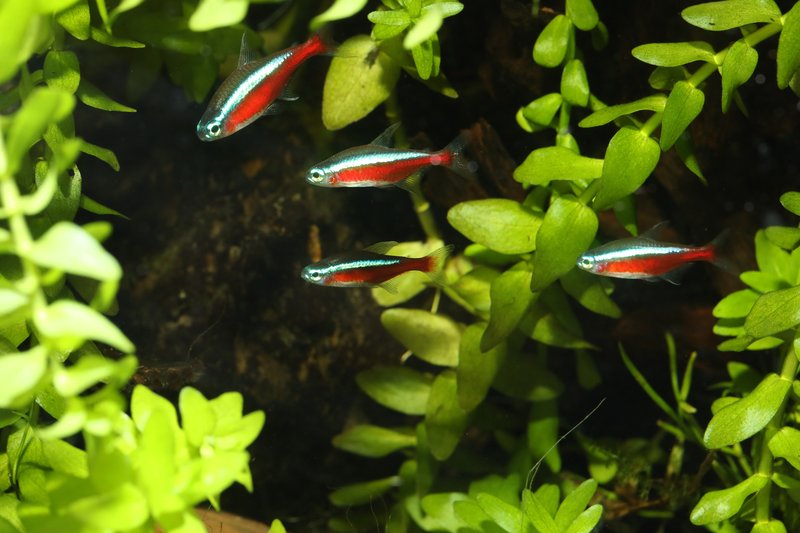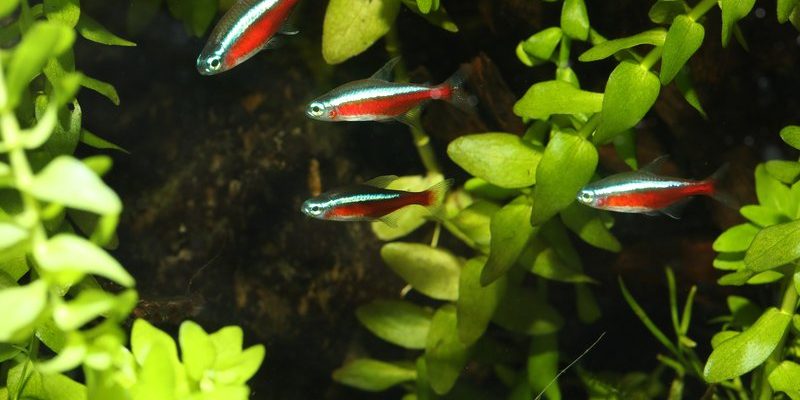
Tetras are small, vibrant fish that grace many aquariums around the world. Known for their striking colors and peaceful demeanor, they make fantastic pets for beginners and experienced aquarists alike. You might picture a tank filled with these lively creatures, darting around like little rainbows as they explore their underwater habitat. But what makes them so special? Let’s dive into the fascinating world of tetras to understand their characteristics, habitats, and care needs.
Originating from various parts of South America, tetras come in a dazzling array of species, each with its own unique traits. From the common Neon Tetra to the elegant Glowlight Tetra, these fish are not just beautiful but also an important part of the aquarium ecosystem. They are known for their schooling behavior, which means they thrive in groups, bringing life and excitement to any aquarium setting. So, if you’re considering adding some colorful companions to your tank, tetras might just be the perfect fit!
What Are Tetras?
Tetras belong to the family Characidae and encompass over 150 different species. These freshwater fish are native to rivers, streams, and lakes, primarily in the Amazon Basin. What’s fascinating about tetras is their adaptability; they can thrive in a variety of environments, which is one reason they are so popular among fish enthusiasts. You’ll often find them swimming together in schools, which not only provides safety in numbers but also creates a beautiful display in your aquarium.
One of their standout features is their bright coloration, which can range from electric blues to fiery reds and deep yellows. This diversity in color is not only appealing to aquarium hobbyists but also serves a purpose in the wild. Bright colors can attract mates or help blend into specific habitats, offering some camouflage from predators. Understanding this trait can help you appreciate what makes these little fish so unique.
Species of Tetras
When it comes to tetras, the options are nearly endless. Some of the most popular species include the Neon Tetra, Cardinal Tetra, and Rummy Nose Tetra. Each of these species has its own distinct characteristics. For example, the Neon Tetra is known for its brilliant blue body with a striking red stripe running across its belly. On the other hand, the Cardinal Tetra boasts vibrant red with blue accents that can make your aquarium sparkle.
Here’s a table summarizing some interesting details about popular tetra species:
| Species | Size | Coloration | Habitat | Diet |
| Neon Tetra | 1.5 inches | Blue and red | Amazon Basin | Omnivore |
| Cardinal Tetra | 2 inches | Bright red and blue | Amazon River | Omnivore |
| Rummy Nose Tetra | 2 inches | Red head and tail with silver body | Amazon Basin | Omnivore |
Each species also has its own personality. Some tetras are more active and playful, while others prefer to glide peacefully through the water. Just like humans, fish can have their unique quirks. So, observing their behavior can be as entertaining as it is educational!
Habitat and Natural Environment
Tetras are predominantly found in the freshwater rivers and streams of South America. Their natural habitats often include lush vegetation, fallen leaves, and submerged branches, which offer both shelter and food. In the wild, these fish can be seen darting in and out of the vegetation, showcasing their agility and curiosity. This environment not only provides safety from predators but also supports a rich ecosystem of microorganisms and insects that tetras feed on.
To replicate their natural environment in an aquarium, you can create a lush landscape with live plants, driftwood, and rocks. Tetras love to hide and explore, so providing plenty of decorations will keep them happy and healthy. Water quality is also crucial; ensure the tank is well-filtered and maintain stable water conditions. Tetras prefer slightly acidic to neutral pH levels, so keeping an eye on your water parameters will help ensure their well-being.
Diet and Feeding
Feeding tetras can be a fun and rewarding experience, as they are not picky eaters. In the wild, their diet mainly consists of small insects, larvae, and plant matter. In captivity, you can offer them a balanced diet consisting of high-quality flakes, pellets, and occasional live or frozen foods. Foods like brine shrimp or bloodworms are also great options to stimulate their appetite and provide essential nutrients.
It’s important to feed them in moderation. Overfeeding can lead to health issues and poor water quality, which can harm your fish. Typically, feeding them once or twice a day is sufficient. Just make sure to observe how much they consume within a few minutes and adjust accordingly. Remember, a varied diet not only boosts their health but also brings out the best colors in your tetras!
Behavior and Social Structure
Tetras are known for their friendly and social nature. They thrive in schools and feel most comfortable when surrounded by their own kind. Keeping them in groups of at least six is recommended to help reduce stress and encourage more natural behavior. In a smaller group, they may become shy and develop poor health. Watching them school together is not just a treat for the eyes; it’s a fundamental aspect of their well-being.
You might notice that tetras exhibit unique behaviors, especially when they feel threatened or excited. They can display rapid darting movements or group swimming patterns that not only create a stunning visual but also serve as a way to communicate. Like many fish, they also have a pecking order within their schools, which helps maintain harmony and reduce aggression.
Breeding Tetras
Breeding tetras can be an exhilarating experience for any fishkeeper. Most tetras are egg scatters, meaning they release eggs into the water rather than laying them in a nest. If you’re interested in breeding, you might want to set up a separate breeding tank. This tank should have soft, slightly acidic water, as this mimics their natural spawning conditions.
When ready, introduce a male and female tetra into the breeding tank. Typically, the male will display more vibrant colors to attract the female. Once they lay eggs, it’s essential to remove the parents, as they may eat the eggs. After a few days, you’ll see tiny fry swimming, and that’s when the real fun begins! Feeding them infusoria or finely crushed flakes will help them grow strong and healthy.
Common Health Issues
Like all fish, tetras are susceptible to certain health problems. One of the most common issues is fin rot, which can be caused by poor water quality or injuries. If you notice fraying fins or discoloration, it’s crucial to address the water conditions and isolate affected fish if necessary. Regular tank maintenance, including water changes and monitoring for signs of stress, helps prevent these issues.
Other common ailments include ich (white spot disease) and various parasitic infections. Keeping an eye on your fish’s behavior is key. If you notice unusual swimming patterns or lack of appetite, it’s worth investigating further. Early detection can be crucial to treating any illnesses quickly and effectively.
Creating the Perfect Tetra Aquarium
Designing an ideal habitat for your tetras involves several key factors. First, consider the tank size; a minimum of 20 gallons is recommended for a school of tetras. This gives them ample space to swim and explore. The right filtration system is also important to keep the water clean and oxygenated.
When it comes to decorations, aim for a balance between open swimming areas and hiding spots. Live plants not only beautify the tank but also help maintain water quality. Adding rocks, driftwood, and plants can create a more natural feel—just make sure that nothing is sharp or can harm your fish. Finally, monitor water temperature and quality regularly. Tetras thrive in slightly warmer waters, typically between 72°F and 80°F.
Tetras are truly remarkable fish that can bring joy and color into your home. With their captivating presence, peaceful nature, and easy care requirements, they’re an excellent choice for anyone interested in the world of aquatics. By providing a suitable environment and proper care, you can enjoy watching these vibrant creatures thrive in your aquarium for years to come. Whether you’re a seasoned aquarist or a newcomer, tetras will surely make a lovely addition to your aquatic family.
FAQ
What is the average lifespan of a tetra?
The average lifespan of a tetra can vary by species, but most tetras live between 5 to 10 years when properly cared for. Factors such as water quality, diet, and overall tank conditions play significant roles in their longevity. Providing a stable and healthy environment is crucial in helping your tetras thrive.
Can tetras live with other fish?
Yes, tetras are generally peaceful and can coexist with a variety of other community fish. However, it’s important to avoid aggressive species that may threaten or harass them. Ideal tank mates include peaceful fish such as guppies, platies, and corydoras catfish. Always research compatibility before introducing new fish into your aquarium.
Are tetras easy to care for?
Tetras are considered beginner-friendly due to their hardiness and straightforward care requirements. They adapt well to a range of water conditions and are relatively undemanding. However, maintaining clean water and providing proper nutrition is essential for their health. New fishkeepers will find that tetras are a rewarding species to keep.
What should I feed my tetras?
Tetras are omnivores, and their diet should include a mix of high-quality flakes, pellets, and live or frozen foods. They enjoy brine shrimp, daphnia, and bloodworms, which can enhance their diet. Feeding them a varied diet is beneficial for their health and helps bring out their vibrant colors.
How can I tell if my tetra is sick?
Signs of illness in tetras may include loss of appetite, abnormal swimming patterns, or visible physical changes such as discoloration or frayed fins. Monitoring your fish regularly can help catch illnesses early, increasing the chances of successful treatment. If you suspect your tetra is unwell, it’s best to consult an aquatic vet or do further research for appropriate remedies.
Do tetras need a heater in their tank?
While not all tetras require a heater, many tropical species thrive in warmer waters (72°F to 80°F). If your home has fluctuating temperatures, it’s wise to invest in a heater to maintain a stable environment. Keeping water temperature consistent can help prevent stress and health issues in your fish.
Can I breed tetras in a community tank?
Breeding tetras in a community tank can be challenging, as other fish may eat the eggs or fry. If you’re interested in breeding, it’s best to set up a separate breeding tank specifically for this purpose. This allows you to control the conditions better and increases the chances of successfully raising fry.
How many tetras should I keep together?
It is recommended to keep at least six tetras together. They are schooling fish and feel safest in groups. Keeping them in smaller numbers can lead to stress and aggression. A bigger school will encourage natural behaviors, making for a more lively and enjoyable aquarium.
What is the ideal tank size for tetras?
A minimum tank size of 20 gallons is suggested for a school of tetras. This provides enough space for them to swim and explore without feeling cramped. Larger tanks allow for better water quality and can accommodate more fish while minimizing stress and aggression.
Are there any special water condition requirements for tetras?
Tetras prefer slightly acidic to neutral pH levels, typically between 6.0 and 7.5. Additionally, they thrive in well-filtered water with stable temperatures. Regular water changes and monitoring can help ensure your tetras remain healthy and happy.

